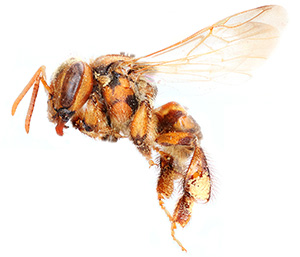Notes on South American stingless bees of the genus Scaptotrigona (Hymenoptera: Apidae), Part III: A revised infrageneric classification and new species
DOI:
https://doi.org/10.17161/jom.i111.17013Abstract
This is the third part of a series on various taxonomic matters regarding the Neotropical stingless bee genus Scaptotrigona Moure (Apinae: Meliponini). Here, an infrageneric classification is established, with Sakagamilla Moure resurrected for the tubiba group, while Scaptotrigona Moure, s.str., encompasses the postica group. A key to subgenera is presented and five new subgenera are established: Eoscaptotrigona Engel, new subgenus; Dasytrigona Engel, new subgenus; Gymnotrigona Engel, new subgenus; Baryorygma Engel, new subgenus; and Astegotrigona Engel, new subgenus. The former bipunctata species group is considered to embody two unrelated groups and species of the luteipennis group also belong among these. Six new species are described, two of which would have formerly been included in the bipunctata group, and the remainder belong to the depilis group: Scaptotrigona (Eoscaptotrigona) totobi Engel, new species, from Venezuela and Colombia; S. (Gymnotrigona) psile Engel, new species, from Venezuela; S. (Gymnotrigona) aurantipes Engel, new species, from Venezuela; S. (Gymnotrigona) nuda Engel, new species, from Bolivia; S. (Gymnotrigona) stipula Engel, new species, from Brazil; S. (Baryorygma) fimbriata Engel, new species, from Bolivia.
Metrics
References
Engel, M.S. 2022a. Notes on South American stingless bees of the genus Scaptotrigona (Hymenoptera: Apidae), part I: Short-bristle species, the tubiba species group. Entomologist’s Monthly Magazine 158(1): 41–59.
Engel, M.S. 2022b. Notes on South American stingless bees of the genus Scaptotrigona (Hymenoptera: Apidae), part II: Subgroup A of the postica species group. Journal of Melittology 110: 1–51.
Engel, M.S., H.W. Herhold, S.R. Davis, B. Wang, & J.C. Thomas. 2021. Stingless bees in Miocene amber of southeastern China (Hymenoptera: Apidae). Journal of Melittology 105: 1–83.
Guérin-Méneville, F.E. 1829–1838 [1844]. Iconographie du Règne Animal de G. Cuvier, ou représentation d'après nature de l'une des espèces les plus remarquables, et souvent non encore figurées, de chaque genre d'animaux. Avec un texte descriptif mis au courant de la science. Ouvrage pouvant servir d'atlas à tous les traités de Zoologie. Insectes. J.B. Baillière; Paris, Royaume de France; [iv]+576 pp., +110 pls. [Nota bene: while the text is from August or September 1844, plates date from March 1829 through December 1837; T. mexicana (as Trigone mexicaine), does not appear in the plates and its only account is found in the 1844 text].
Laroca, S., & M.C. de Almeida. 2015. Scaptotrigona marialiceae, a new species of neotropical stingless bee (Hym., Anthophila), from southern Brazil. Acta Biológica Paranaense 44(1–2): 1–6.
Latreille, P.A. 1807. Genera Crustaceorum et Insectorum secundum ordinem naturalem in familias disposita, iconibus exemplisque plurimus explicata [Tomus Tertius]. A. Koenig; Paris, Empire français; 258+[i] pp.
Moure, J.S. 1942. Abelhas de Salobra (Hym. Apoidea). Papéis Avulsos do Departamento de Zoologia 2(21): 291–321.
Moure, J.S. 1950. Notas sobre alguns Meliponinae Bolivianos (Hymenoptera, Apoidea). Dusenia 1(1): 70–80.
Moure, J.S. 1964. Uma nova espécie de Trigonini do território do Amapá (Hymenoptera-Apoidea). Boletim da Universidade do Paraná, Zoologia 2(4): 57–58.
Moure, J.S. 1989. Sakagamilla affabra, gen. n. e sp. n. de Meliponinae (Hymenoptera, Apidae) de Rondônia. Revista Brasileira de Zoologia 6(4): 681–684.
Roubik, D.W., J.A. Lobo Segura, & J.M.F. de Camargo. 1997. New stingless bee genus endemic to Central American cloudforests: Phylogenetic and biogeographic implications (Hymenoptera: Apidae: Meliponini). Systematic Entomology 22(1): 67–80.

Downloads
Published
Issue
Section
License
Copyright (c) 2022 Michael S. Engel

This work is licensed under a Creative Commons Attribution-NonCommercial-NoDerivatives 4.0 International License.
Copyright for articles published in Journal of Melittology is retained by the authors, with first publication rights granted to the journal. By virtue of their appearance in this open access journal, articles are free to use, with proper attribution and permission of the authors, in educational and other non-commercial settings.




